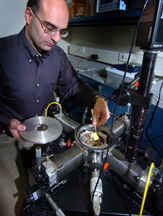
| RELATED INFO |
| * Farshid Sadeghi |
| * Dimitrios Peroulis |

October 30, 2007
Purdue creating wireless sensors to monitor bearings in jet engines
WEST LAFAYETTE, Ind. - |
The devices are an example of an emerging technology known as "micro electromechanical systems," or MEMS, which are machines that combine electronic and mechanical components on a microscopic scale.
"The MEMS technology is critical because it needs to be small enough that it doesn't interfere with the performance of the bearing itself," said Farshid Sadeghi, a professor of mechanical engineering. "And the other issue is that it needs to be able to withstand extreme heat."
The engine bearings must function amid temperatures of about 300 degrees Celsius, or 572 degrees Fahrenheit.
The researchers have shown that the new sensors can detect impending temperature-induced bearing failure significantly earlier than conventional sensors.
"This kind of advance warning is critical so that you can shut down the engine before it fails," said Dimitrios Peroulis, an assistant professor of electrical and computer engineering.
Findings will be detailed in a research paper to be presented on Tuesday (Oct. 30) during the IEEE Sensors 2007 conference in Atlanta, sponsored by the Institute of Electrical and Electronics Engineers. The paper was written by electrical and computer engineering graduate student Andrew Kovacs, Peroulis and Sadeghi.
The sensors could be in use in a few years in military aircraft such as fighter jets and helicopters. The technology also has potential applications in commercial products, including aircraft and cars.
"Anything that has an engine could benefit through MEMS sensors by keeping track of vital bearings," Peroulis said. "This is going to be the first time that a MEMS component will be made to work in such a harsh environment. It is high temperature, messy, oil is everywhere, and you have high rotational speeds, which subject hardware to extreme stresses."
The work is an extension of Sadeghi's previous research aimed at developing electronic sensors to measure the temperature inside critical bearings in communications satellites.
"This is a major issue for aerospace applications, including bearings in satellite attitude control wheels to keep the satellites in position," Sadeghi said.
The wheels are supported by two bearings. If mission controllers knew the bearings were going bad on a specific unit, they could turn it off and switch to a backup.
"What happens, however, is that you don't get any indication of a bearing's imminent failure, and all of a sudden the gyro stops, causing the satellite to shoot out of orbit," Sadeghi said. "It can take a lot of effort and fuel to try to bring it back to the proper orbit, and many times these efforts fail."
The Purdue researchers received a grant from the U.S. Air Force in 2006 to extend the work for high-temperature applications in jet engines.
"Current sensor technology can withstand temperatures of up to about 210 degrees Celsius, and the military wants to extend that to about 300 degrees Celsius," Sadeghi said. "At the same time, we will need to further miniaturize the size."
The new MEMS sensors provide early detection of impending failure by directly monitoring the temperature of engine bearings, whereas conventional sensors work indirectly by monitoring the temperature of engine oil, yielding less specific data.
The MEMS devices will not require batteries and will transmit temperature data wirelessly.
"This type of system uses a method we call telemetry because the devices transmit signals without wires, and we power the circuitry remotely, eliminating the need for batteries, which do not perform well in high temperatures," Peroulis said.
Power will be provided using a technique called inductive coupling, which uses coils of wire to generate current.
"The major innovation will be the miniaturization and design of the MEMS device, allowing us to install it without disturbing the bearing itself," Peroulis said.
Data from the onboard devices will not only indicate whether a bearing is about to fail but also how long it is likely to last before it fails, Peroulis said.
The research is based at the Birck Nanotechnology Center in Purdue's Discovery Park and at Sadeghi's mechanical engineering laboratory.
Writer: Emil Venere, (765) 494-4709, venere@purdue.edu
Sources: Farshid Sadeghi, (765) 494-5719, sadeghi@ecn.purdue.edu
Dimitrios Peroulis, 765 494-3491, dperouli@purdue.edu
Purdue News Service: (765) 494-2096; purduenews@purdue.edu
Note to Journalists: An electronic version of the research paper is available from Emil Venere, (765) 494-4709, venere@purdue.edu
PHOTO CAPTION:
Dimitrios Peroulis, an assistant professor of electrical and computer engineering at Purdue, holds a new MEMS sensor at an "environmentally controlled probe station." The wireless sensors are being developed to detect impending bearing failure in jet engines. The probe station recreates extreme conditions inside engines, enabling researchers to test the sensors. (Purdue News Service photo/David Umberger)
A publication-quality photo is available at https://www.purdue.edu/uns/images/+2007/peroulis-sensors.jpg
Early-Warning Wireless Telemeter for Harsh-Environment Bearings
Andrew Kovacs, Dimitrios Peroulis, Farshid Sadeghi
School of Electrical and Computer Engineering, Birck Nanotechnology Center
School of Mechanical Engineering
Purdue University West Lafayette, IN 47905
We demonstrate an early-warning wireless and high-temperature telemeter that continuously monitors the temperature of a roller bearing during operation. The telemeter detects imminent temperature-induced failure of the bearing four minutes before conventional thermocouple sensors respond to conditional changes, leaving ample time for appropriate actions to avoid complete failure. The telemeter includes a commercially available temperature-sensitive capacitor that operates up to 220±C. In addition, the telemeter's natural frequency changes with capacitance, which in turn is dependant on temperature. Information transmission between the bearing and a monitoring station is accomplished with a matched interrogator driven by a sinusoidal signal at 2.27MHz. The telemeter's natural frequency shifts by about 0.65kHz/±C, which is measured as a change in voltage on the interrogator inductor.
To the News Service home page
If you have trouble accessing this page because of a disability, please contact Purdue News Service at purduenews@purdue.edu.
